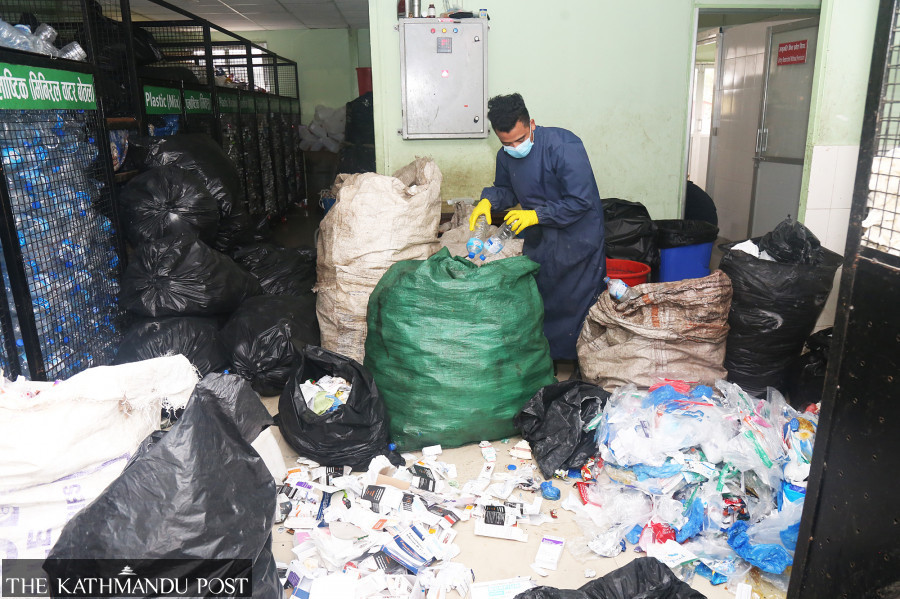Kathmandu
KMC starts monitoring waste management practices of health facilities
A team led by Deputy Mayor Sunita Dangol has started monitoring waste management practices of health facilities. The move aims to prevent the practices of mixing up hazardous medical waste with household waste.
Post Report
The Kathmandu Metropolitan City has intensified vigilance of household waste disposal at the landfill site and started monitoring the waste management practices of health facilities.
The move of the Environment Department under the metropolis is aimed at preventing the practices of mixing up hazardous medical waste with household waste.
“Today we fined Rs50,000 to a private organisation that tried to dump hospital waste at the Bancharedanda landfill site,” said Rabin Man Shrestha, chief of the department. “We have also started monitoring waste management practices of hospitals. A team led by the deputy mayor [Sunita Dangol] has monitored waste management practices of some hospitals.”
Hospital waste management is a neglected issue in Kathmandu. Along with private health facilities, including hospitals, nursing homes, polyclinics, and laboratories, state-run health facilities also mix up hazardous medical waste with household waste.
The organisation, which collects household garbage in the Valley, had mixed up hazardous hospital waste with household waste and taken it to a landfill site to dump, officials said, without revealing the name of the organisation.
Officials at the Environment Department of the metropolis said that they have already inspected waste management practices of some hospitals—Kathmandu Model Hospital, B & B Hospital, and Kirtipur Hospital—and cautioned them not to mix up the hazardous waste with other waste materials.
“First we will remind hospital owners about the rules and their responsibilities and caution them,” said Shrestha. “Legal action will be taken in the second phase if found violating the rules.”
Monitoring the waste management practices by the metropolis and charging fines to the waste collecting organisation is not a new thing and is not done for the first time.
In December last year also, the city office detained a garbage truck along with its driver for dumping hazardous hospital waste at the landfill site.
KMC officials said that the ongoing monitoring is launched as a campaign, which will be continued for a month.
“We have issued a public notice asking health facilities to follow the rules properly,” Shrestha said. “Inspection will be carried out in big hospitals in the initial stage and later it will be done at private clinics and polyclinics.”
Many health facilities including state-run hospitals do not have their waste disposal system. Doctors say mixing hospital waste with household waste poses a serious threat of spreading infections—HIV, Hepatitis B, Hepatitis C, tuberculosis, tetanus, and coronavirus—to those handling the waste.
Officials said that not only the metropolis’s cleaning staff but also ragpickers get injured and infected by the needles used in the health facilities. The risks of spread of infections in communities grow when hazardous waste is mixed up with household waste.
It is estimated that there are over 2,100 health facilities in operation in KMC alone. Most health facilities discard medical waste mixing it up with household waste. Some also burn such waste out in the open, they admit.
Experts say burning medical waste is the worst idea as it can produce dioxin, furan and other hazardous chemicals, which can even cause cancer. Pathological waste contains harmful microorganisms—bacteria and viruses—which can easily spread if not managed properly.
A report published by the Ministry of Health and Population in 2020 showed that private hospitals were rampantly burning, burying and disposing of hazardous immunisation waste and mixing it up with municipal waste.
The study titled ‘Assessment of Immunisation Services in the Private Sector in Kathmandu Valley’—carried out by the Health Ministry and a consortium of Atlanta’s Center for Disease Control and Prevention, Johns Hopkins University, John Snow Institute—showed that only 7.7 percent of private health facilities were found practising the disinfection and recycling method.
According to the study, 19.2 percent of private health facilities were found burning immunisation waste, 15.4 percent were disposing of hazardous immunisation waste along with municipal waste and 2 percent of health facilities were found burying hazardous needles.
The World Health Organisation says hazardous waste poses many health risks such as the potential to inflict physical injury (stabs from sharp and pointed items such as needles), chemical burns, toxic exposure to pharmaceuticals, radiation exposure, and exposure to infectious and disease-causing microorganisms.




 16.12°C Kathmandu
16.12°C Kathmandu










